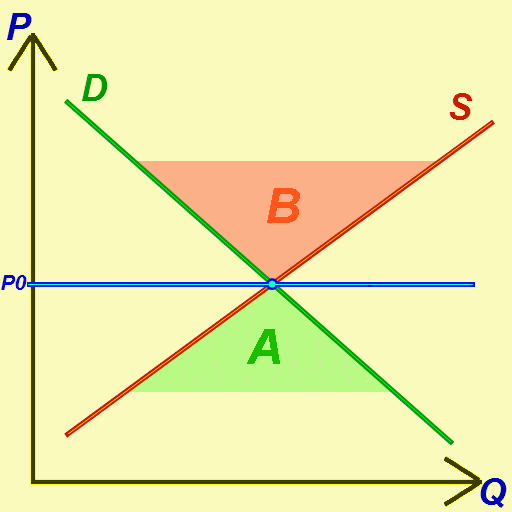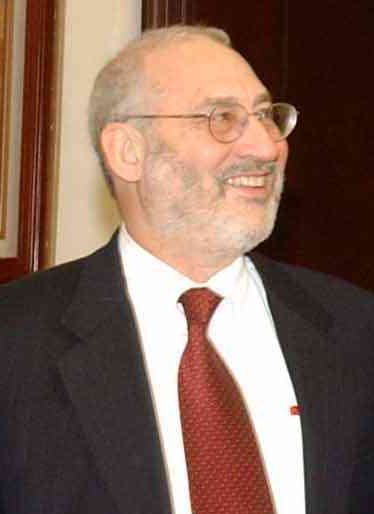|
Shapiro–Stiglitz Theory
In labour economics, Shapiro–Stiglitz theory of efficiency wages (or Shapiro–Stiglitz efficiency wage model) is an economic theory of wages and unemployment in labour market equilibrium. It provides a technical description of why wages are unlikely to fall and how involuntary unemployment appears. This theory was first developed by Carl Shapiro and Joseph Stiglitz. Introduction When full employment is achieved, if a worker is sacked, he automatically finds his next job soon. In the circumstances, he does not need to exert his effort in his job, and thus full employment necessarily motivates a worker to shirk provided that he is happy with loafing on the job. Since shirking makes a firm's productivity decline, the firm needs to offer its workers higher wages to eliminate shirking. Then all firms try to eliminate shirking, which pushes up average wages and decreases employment. Hence nominal wages tend to display downward rigidity. In equilibrium, all firms pay the same wage ab ... [...More Info...] [...Related Items...] OR: [Wikipedia] [Google] [Baidu] |
Efficiency Wage
The term efficiency wages (or rather "efficiency earnings") was introduced by Alfred Marshall to denote the wage per efficiency unit of labor. Marshallian efficiency wages would make employers pay different wages to workers who are of different efficiencies such that the employer would be indifferent between more-efficient workers and less-efficient workers. The modern use of the term is quite different and refers to the idea that higher wages may increase the efficiency of the workers by various channels, making it worthwhile for the employers to offer wages that exceed a market-clearing level. Optimal efficiency wage is achieved when the marginal cost of an increase in wages is equal to the marginal benefit of improved productivity to an employer.Mankiw, Gregory N. & Taylor, Mark P. (2008), ''Macroeconomics'' (European edition), pp. 181–182 In labor economics, the "efficiency wage" hypothesis argues that wages, at least in some labour markets, form in a way that is not ma ... [...More Info...] [...Related Items...] OR: [Wikipedia] [Google] [Baidu] |
Economic Theory
Economics () is the social science that studies the production, distribution, and consumption of goods and services. Economics focuses on the behaviour and interactions of economic agents and how economies work. Microeconomics analyzes what's viewed as basic elements in the economy, including individual agents and markets, their interactions, and the outcomes of interactions. Individual agents may include, for example, households, firms, buyers, and sellers. Macroeconomics analyzes the economy as a system where production, consumption, saving, and investment interact, and factors affecting it: employment of the resources of labour, capital, and land, currency inflation, economic growth, and public policies that have impact on these elements. Other broad distinctions within economics include those between positive economics, describing "what is", and normative economics, advocating "what ought to be"; between economic theory and applied economics; between rationa ... [...More Info...] [...Related Items...] OR: [Wikipedia] [Google] [Baidu] |
Unemployment
Unemployment, according to the OECD (Organisation for Economic Co-operation and Development), is people above a specified age (usually 15) not being in paid employment or self-employment but currently available for work during the reference period. Unemployment is measured by the unemployment rate, which is the number of people who are unemployed as a percentage of the labour force (the total number of people employed added to those unemployed). Unemployment can have many sources, such as the following: * new technologies and inventions * the status of the economy, which can be influenced by a recession * competition caused by globalization and international trade * policies of the government * regulation and market Unemployment and the status of the economy can be influenced by a country through, for example, fiscal policy. Furthermore, the monetary authority of a country, such as the central bank, can influence the availability and cost for money through ... [...More Info...] [...Related Items...] OR: [Wikipedia] [Google] [Baidu] |
Market Equilibrium
In economics, economic equilibrium is a situation in which economic forces such as supply and demand are balanced and in the absence of external influences the ( equilibrium) values of economic variables will not change. For example, in the standard text perfect competition, equilibrium occurs at the point at which quantity demanded and quantity supplied are equal. Market equilibrium in this case is a condition where a market price is established through competition such that the amount of goods or services sought by buyers is equal to the amount of goods or services produced by sellers. This price is often called the competitive price or market clearing price and will tend not to change unless demand or supply changes, and quantity is called the "competitive quantity" or market clearing quantity. But the concept of ''equilibrium'' in economics also applies to imperfectly competitive markets, where it takes the form of a Nash equilibrium. Understanding economic equilibr ... [...More Info...] [...Related Items...] OR: [Wikipedia] [Google] [Baidu] |
Carl Shapiro
Carl Shapiro (born 20 March 1955) is an American economist and academic who serves as the Transamerica Professor of Business Strategy at the University of California, Berkeley's Haas School of Business. He is the co-author, along with Hal Varian of '' Information Rules: A Strategic Guide to the Network Economy'', published by the Harvard Business School Press. On February 23, 2011, '' The Wall Street Journal'' reported that President Barack Obama intended to nominate Shapiro to his Council of Economic Advisers. Shapiro served as Deputy Assistant Attorney General for Economics in the Antitrust Division of the U.S. Department of Justice (1995–1996). He is a Senior Consultant with Charles River Associates and has consulted extensively for a wide range of private clients as well as for the U.S. Department of Justice and the Federal Trade Commission. Shapiro was again the Deputy Assistant Attorney General for Economics of the Antitrust division of the Justice Department fr ... [...More Info...] [...Related Items...] OR: [Wikipedia] [Google] [Baidu] |
Joseph Stiglitz
Joseph Eugene Stiglitz (; born February 9, 1943) is an American New Keynesian economist, a public policy analyst, and a full professor at Columbia University. He is a recipient of the Nobel Memorial Prize in Economic Sciences (2001) and the John Bates Clark Medal (1979). He is a former senior vice president and chief economist of the World Bank. He is also a former member and chairman of the (US president's) Council of Economic Advisers. He is known for his support of Georgist public finance theory and for his critical view of the management of globalization, of '' laissez-faire'' economists (whom he calls " free-market fundamentalists"), and of international institutions such as the International Monetary Fund and the World Bank. In 2000, Stiglitz founded the Initiative for Policy Dialogue (IPD), a think tank on international development based at Columbia University. He has been a member of the Columbia faculty since 2001, and received the university's highest acade ... [...More Info...] [...Related Items...] OR: [Wikipedia] [Google] [Baidu] |
Poisson Distribution
In probability theory and statistics, the Poisson distribution is a discrete probability distribution that expresses the probability of a given number of events occurring in a fixed interval of time or space if these events occur with a known constant mean rate and independently of the time since the last event. It is named after French mathematician Siméon Denis Poisson (; ). The Poisson distribution can also be used for the number of events in other specified interval types such as distance, area, or volume. For instance, a call center receives an average of 180 calls per hour, 24 hours a day. The calls are independent; receiving one does not change the probability of when the next one will arrive. The number of calls received during any minute has a Poisson probability distribution with mean 3: the most likely numbers are 2 and 3 but 1 and 4 are also likely and there is a small probability of it being as low as zero and a very small probability it could be 10. ... [...More Info...] [...Related Items...] OR: [Wikipedia] [Google] [Baidu] |
Nominal Rigidity
Nominal rigidity, also known as price-stickiness or wage-stickiness, is a situation in which a nominal price is resistant to change. Complete nominal rigidity occurs when a price is fixed in nominal terms for a relevant period of time. For example, the price of a particular good might be fixed at $10 per unit for a year. Partial nominal rigidity occurs when a price may vary in nominal terms, but not as much as it would if perfectly flexible. For example, in a regulated market there might be limits to how much a price can change in a given year. If one looks at the whole economy, some prices might be very flexible and others rigid. This will lead to the aggregate price level (which we can think of as an average of the individual prices) becoming "sluggish" or "sticky" in the sense that it does not respond to macroeconomic shocks as much as it would if all prices were flexible. The same idea can apply to nominal wages. The presence of nominal rigidity is an important part of macr ... [...More Info...] [...Related Items...] OR: [Wikipedia] [Google] [Baidu] |
Involuntary Unemployment
Involuntary unemployment occurs when a person is unemployed despite being willing to work at the prevailing wage. It is distinguished from voluntary unemployment, where a person refuses to work because their reservation wage is higher than the prevailing wage. In an economy with involuntary unemployment, there is a surplus of labor at the current real wage. This occurs when there is some force that prevents the real wage rate from decreasing to the real wage rate that would equilibrate supply and demand (such as a minimum wage above the market-clearing wage). Structural unemployment is also involuntary. Economists have several theories explaining the possibility of involuntary unemployment including implicit contract theory, disequilibrium theory, staggered wage setting, and efficiency wages. The officially measured unemployment rate is the ratio of involuntary unemployment to the sum of involuntary unemployment and employment (the denominator of this ratio being the total lab ... [...More Info...] [...Related Items...] OR: [Wikipedia] [Google] [Baidu] |
Nominal Rigidity
Nominal rigidity, also known as price-stickiness or wage-stickiness, is a situation in which a nominal price is resistant to change. Complete nominal rigidity occurs when a price is fixed in nominal terms for a relevant period of time. For example, the price of a particular good might be fixed at $10 per unit for a year. Partial nominal rigidity occurs when a price may vary in nominal terms, but not as much as it would if perfectly flexible. For example, in a regulated market there might be limits to how much a price can change in a given year. If one looks at the whole economy, some prices might be very flexible and others rigid. This will lead to the aggregate price level (which we can think of as an average of the individual prices) becoming "sluggish" or "sticky" in the sense that it does not respond to macroeconomic shocks as much as it would if all prices were flexible. The same idea can apply to nominal wages. The presence of nominal rigidity is an important part of macr ... [...More Info...] [...Related Items...] OR: [Wikipedia] [Google] [Baidu] |

